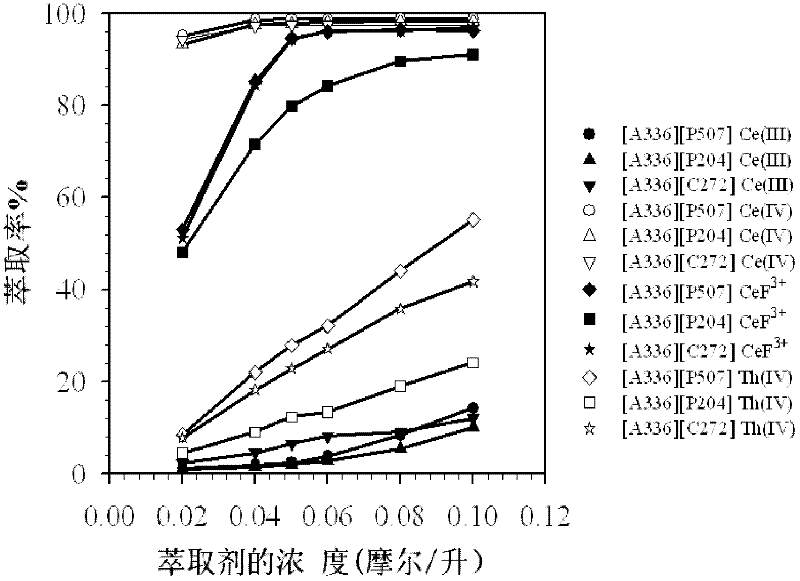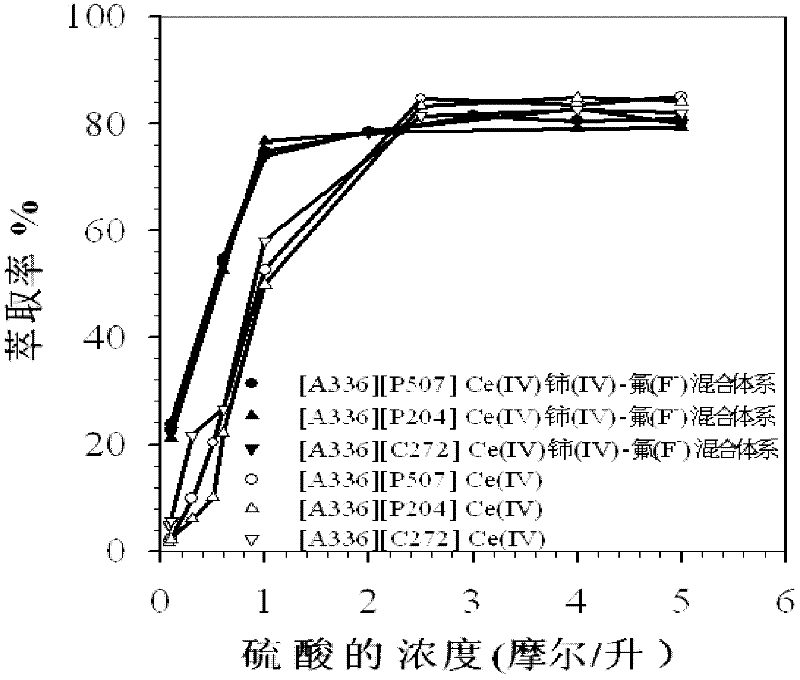Method for separating tetravalent cerium or tetravalent cerium and fluorine
A cation and anion technology, applied in the field of separation of tetravalent cerium or tetravalent cerium and fluorine, can solve the problems of high production cost and serious environmental pollution, achieve less acid and alkali consumption, reduce environmental pollution, and achieve good separation effect
- Summary
- Abstract
- Description
- Claims
- Application Information
AI Technical Summary
Problems solved by technology
Method used
Image
Examples
Embodiment 1
[0068] In the reactor, add 6.39g of sodium metal and 125mL of distilled isopropanol to react at room temperature. After 3 hours of reaction, a solution of sodium isopropoxide is obtained, and continue to add 500mL of distilled, dissolved in 112.36g of methyl alcohol. The isopropanol solution of trioctylammonium chloride was reacted. After stirring at 50°C for 4 hours, the centrifuge was used to centrifuge the obtained isopropanol solution at a speed of 8000r / min for 10min. After collecting the filtrate by filtration, pour it into the filtrate Add 500mL of deionized water and shake for 30min to obtain a methyl trioctyl ammonium hydroxide ([A336][OH]) solution.
[0069] Take 1 mL of the obtained [A336][OH] solution, use bromothymol blue as an indicator, and titrate with hydrochloric acid with a concentration of 0.132 mol / L to obtain a concentration of [A336][OH] of 0.121 mol / L.
Embodiment 2
[0071] In the reactor, add 172mL of the [A336][OH] solution prepared in Example 1 and 6.25g of P507, reflux and stir at 50°C for 12h, put the stirred solution to stand and separate phases, take the upper phase at 80°C, 20mbar Contained isopropanol and water are spinned out at the bottom to obtain the mono-2-ethylhexylphosphonic acid ionic liquid ([A336][P507]) of methyl trioctyl ammonium 2-ethylhexyl ester, and its proton nuclear magnetic resonance spectrum and nuclear magnetic resonance The spectrogram data of the carbon spectrum are as follows:
[0072] 1 H NMR: 0.822-0.847(t, J=8.4Hz, 3H), 0.851-0.872(t, J=8.4Hz, 3H), 0.875-0.894(t, J=6.6Hz, 9H), 1.264(s, 30H ), 1.287-1.298(m, 6H), 1.330-1.408(m, 12H), 1.419-1.454(m, 2H), 1.466-1.515(m, 2H), 1.539-1.583(m, 1H), 1.609-1.677 (m, 6H), 1.710-1.779(m, 1H), 2.699(s, 2H), 3.322(s, 3H), 3.404-3.432(t, J=8.4Hz, 6H), 3.672-3.705(m, 2H );
[0073] 13C NMR: 65.87, 61.00(3C), 48.82, 40.55, 34.80, 33.75, 31.65, 31.49(2C), 30.0(2C), ...
Embodiment 3
[0075] In the reactor, add 177mL of the [A336][OH] solution prepared in Example 1 and 8.01g of P204, reflux and stir at 50°C for 12h, leave the stirred solution to separate phases, take the upper phase at 80°C, 20mbar Contained isopropanol and water are spinned out at the bottom to obtain methyl trioctyl ammonium di(2-ethylhexyl) phosphonic acid ionic liquid ([A336][P204]), the data of its proton nuclear magnetic resonance spectrum and carbon nuclear magnetic resonance spectrum They are as follows:
[0076] 1 H NMR: 0.854-0.870 (m, 6H), 0.876-0.894 (m, 9H), 1.265-1.274 (m, 30H), 1.282-1.296 (m, 6H), 1.308-1.358 (m, 12H), 1.370- 1.411(m, 4H), 1.424-1.470(m, 1H), 1.500-1.530(m, 1H), 1.613-1.677(m, 6H), 3.294(s, 3H), 3.375-3.403(t, J=7.8Hz , 6H), 3.711-3.745(m, 4H);
[0077] 13 C NMR: 10.66(2C), 13.70, 13.74, 13.80, 22.11(3C), 22.28(3C), 22.33(3C), 22.87(3C), 23.06(3C), 26.09(2C), 28.77, 28.81(2C) , 28.91 (2C), 28.95, 29.12, 29.16, 29.85, 31.38, 31.54, 40.14, 48.59, 60.93, 6...
PUM
 Login to View More
Login to View More Abstract
Description
Claims
Application Information
 Login to View More
Login to View More - R&D
- Intellectual Property
- Life Sciences
- Materials
- Tech Scout
- Unparalleled Data Quality
- Higher Quality Content
- 60% Fewer Hallucinations
Browse by: Latest US Patents, China's latest patents, Technical Efficacy Thesaurus, Application Domain, Technology Topic, Popular Technical Reports.
© 2025 PatSnap. All rights reserved.Legal|Privacy policy|Modern Slavery Act Transparency Statement|Sitemap|About US| Contact US: help@patsnap.com



